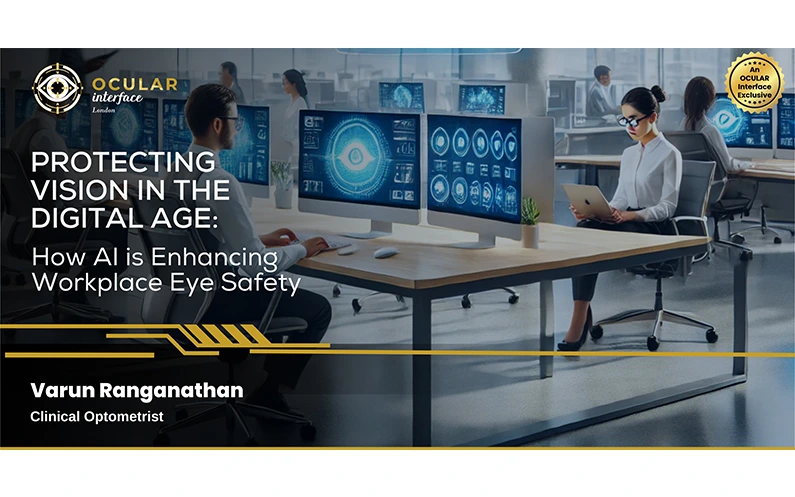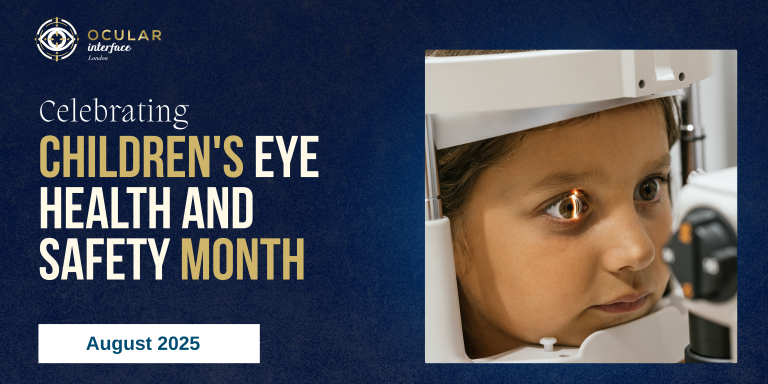Varun Ranganathan, MCOptom
Clinical Optometrist
An OCULAR Interface Exclusive
Synopsis:
In today’s digital-driven workplaces, prolonged screen exposure and hazardous environments pose significant risks to eye health. This blog explores how artificial intelligence (AI) is transforming workplace eye safety by detecting early signs of digital eye strain, optimising lighting conditions, and ensuring compliance with protective eyewear regulations. By integrating AI into workplace safety protocols, businesses can create healthier, more productive work environments while safeguarding employees’ vision.
Introduction:
The health and safety of employees in a workplace is an important consideration in running an organisation. It ensures that the individuals’ well-being is safeguarded and promoted, and any grievances are brought to notice. Even with all protocols in place, work-related risks and hazards are real and are a common occurrence. Companies employ safety officers to make sure stringent protocols are in place, but subtle signs can be overlooked or missed.
Workplace eye safety is becoming increasingly common due to the digital age and the majority of tasks are performed using computers and the time spent on screens is also increasing. 1
Most common ocular issues associated with computer vision syndrome 2 include:
- Refractive error
- Asthenopia
- Ocular surface disorders
- Accommodation and convergence disorders
Role of AI in Workplace Safety
Ergonomics for Desk Workers
AI enables real-time monitoring of workplace hazards, identifying and addressing risks proactively. Predictive analytics, a process by which historic data is used to forecast future outcomes, is used to enhance preventive measures. The incorporation of AI not only improves safety protocols but also utilises a comprehensive approach to employee well-being, with increased efficiency and precision.
Applications are now available on computers using AI to monitor Digital Eye Strain (DES) which can detect when a person’s blink rate is down. The application reminds the person to follow an unofficial but popular 20-20-20 rule to take a break from screen and blink normally. 3
Musculoskeletal disorders (MSD) from workplace activities are steadily growing and it has a huge impact on both productivity of an organisation and on the individual. In the UK across all industries around 7.3 million working days were lost in 2021/2022. This was due to COVID-19 where the majority of employees were working from home. 4 Computer vision is a branch of AI which can aid in object detection and image recognition. It is increasingly being used by organisations to monitor and intervene in workplace ergonomics. Posture assessments can be carried out using AI and smart workstations can be setup to reduce the risk of MSD. 5
Smart Safety-Eyewear
Safety eyewear is mandatory in many heavy industries and serves an important purpose in protecting employees’ eyes from work-related hazards. Until the early 1990s, work-related eye injuries were very common in the UK, some of which were quite devastating and had long-term impacts since workers with eye injuries were 30% less likely to be employed than those without. 6 Smart safety eyewear first introduced in 2024 is AI-integrated and works with voice-recognition for seamless communication and instructions in workplace. These glasses have touch-sensitive controls with anti-fogging and photochromic properties to provide clear and uninterrupted vision. 7
Detecting Fatigue Levels through Eyes
Systemic fatigue levels can be detected by physiological changes in eyes such as blinking frequency and duration and pupil size. This method was first used in detecting fatigue levels when driving a car but the same can be used in industrial settings due to the high risk to life scenarios. Wearable devices such as smart glasses can detect systemic fatigue and alert the workers, especially near danger zones and can also alert managers about susceptible workers. 8 Fixation time, pupil size and palpebral fissure are often used to evaluate fatigue and smart glasses with sensors to measure these constantly can help in alerting workers about their fatigue levels.
Conclusion
As AI technology continues to evolve, its potential to safeguard workplace eye health will only expand. Employers that integrate AI-driven eye safety solutions can reduce productivity losses due to vision-related discomfort, enhance employee well-being, and foster a healthier work environment. By leveraging AI for workplace eye safety, businesses are taking a proactive approach to vision health, ensuring that employees can work comfortably and efficiently in the digital age.
References:
- Sheppard A.L., Wolffsohn J.S. Digital eye strain: Prevalence, measurement and amelioration. BMJ Open Ophthalmol. 2018;3:e000146. doi: 10.1136/bmjophth-2018-000146.
- Alamri A, Amer KA, Aldosari AA, Althubait BMS, Alqahtani MS, Al Mudawi AAM, Al Mudawi BAM, Alqahtani FAM, Alhamoud NSY. Computer vision syndrome: Symptoms, risk factors, and practices. J Family Med Prim Care. 2022 Sep;11(9):5110-5115. doi: 10.4103/jfmpc.jfmpc_1627_21. Epub 2022 Oct 14. PMID: 36505560; PMCID: PMC9730965.
- Blink Detection Software to Reduce Digital Eye Strain – Artificial intelligence blink detection software to help prevent eye fatigue, strain, and dryness.
- https://www.nhsemployers.org/publications/musculoskeletal-health-workplace
- https://cerebrumedge.com/blog/entry/msd-risk-due-to-prolonged-static-posture
- https://www.who.int/news/item/15-09-2023-ilo-iapb-eye-health-and-the-world-of-work
- https://lucyd.co/blogs/blog/next-gen-safety-meets-smart-tech-how-lucyd-eyewear-s-ai-integrated-glasses-are-revolutionizing-protective-eyewear?srsltid=AfmBOoqfrJ2zih31J7CdTG9g4J85_O8NSGbeywuaIcvYTr7KC2F51xpH
- https://www.viact.ai/post/the-future-of-safety-aiot-wearable-technology-for-the-modern-workplace










